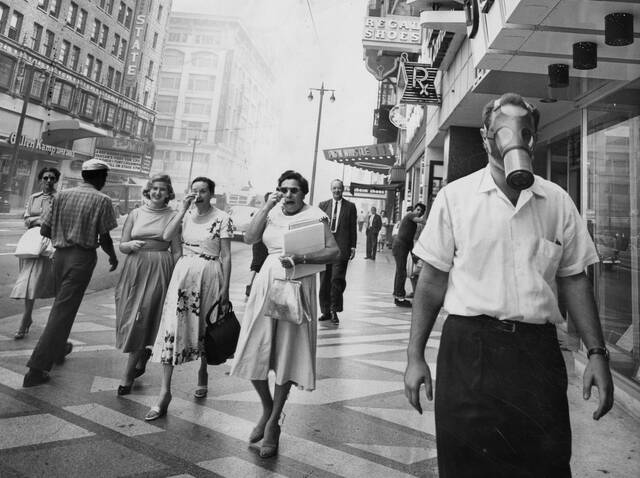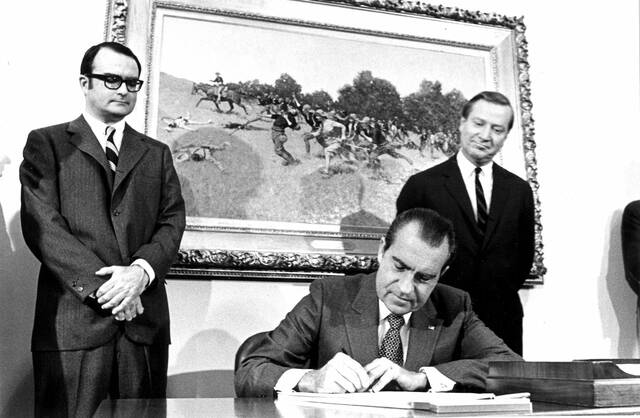TV Talk: PBS’s ‘Clearing the Air' shows how Western Pa. played a role in 20th-century smog crises
Trib Total Media TV writer Rob Owen offers a viewing tip for the coming week.
PBS’s “American Experience” explores bipartisan efforts to improve the quality of American air in the 20th century in “Clearing the Air: The War on Smog.” And Donora, Washington County, has a starring role in the one-hour film that airs at 9 p.m. Tuesday on WQED-TV.
While “Clearing the Air” is largely about the smog crisis that began in Los Angeles in 1943 and bipartisan efforts to remediate the problem, the October 1948 Donora smog event that killed at least 20 people further spooked Los Angelenos, leading to additional calls for environmental protection.
“It was striking how important what happened in Donora was for the nation,” said “Clearing the Air” director Peter Yost in a recent phone interview. “It quickly became not just a regional but a national and even an international story. The people in Los Angeles at that point in the late ’40s were wrestling with what was essentially a mystery about what was happening to their air: Why were cars crashing because (drivers) couldn’t see? Why were people coughing? Why were people moving out because of this kind of silvery-blue haze? They didn’t understand scientifically where it was coming from, and Donora spurred them — because it was such a horrible tragedy — to try to get to the bottom of what was going on there.”
Yost described people in Los Angeles carrying signs that read, “Not another Donora here.”
“They saw it, as somebody says in our film, as a ‘potential coming attraction for L.A.’,” Yost said.
Ultimately, there were different variables in the cause of the smog in Donora and in L.A., but pollution in both cities rallied people to prod politicians and scientists to investigate and take action.
“It’s not pushing it too hard to say that Donora helped propel L.A., and L.A., in turn, was the motivation for the creation and the model of the National Clean Air Act decades later, which became the first major piece of legislation and the fundamental core of the Environmental Protection Agency,” Yost said.
Perhaps what’s most striking about “Clearing the Air” is the evidence it presents that a clean environment with healthy-to-breathe air was once a nonpartisan issue, unlike today.
“It’s not hyperbole to use the term ‘dismantling’ to describe what’s happening to virtually all of these environmental protections that were won over many, many decades of hard, bipartisan work,” Yost said. “What this film offers, arguably, is a deep dive into one narrow but deeply important story that showed how hard but important it is to do that kind of work. … It’s inspiring to see that this can work and that we’ve made it work. But it has a sad echo today, given where we are.”
Yost notes “Clearing the Air” shows how people united across all political beliefs.
“On the ground in California, Ronald Reagan was the governor, and he was no innate environmentalist, but he could see reality … He was a good politician, and he reacted accordingly, and created what essentially led to the first Clean Air Act,” Yost said. “The federal legislation and the creation of the EPA were spearheaded by Richard Nixon, who, needless to say, was also not a tie-dye wearing environmentalist. But he was able to read the political winds and understood that this was something that people across party lines could agree on.
“There was a shared middle ground of common sense,” Yost continued. “It doesn’t matter if you’re a Democrat or a Republican, if you can’t send your kids to school because they’re coughing all the time, or you need to leave a city because the air is too bad for you, that’s something we all might want to work together on.”
Yost was drawn to the subject in “Clearing the Air” for multiple reasons, including the story’s dramatic elements.
“Present-day notwithstanding, it’s a happy story,” he said. “It’s a success story. It took decades to pick away at this and come up with a solution, but the results are unmissable and incontrovertible and striking, and I think they hold lessons for us all.”
History-focused “American Experience,” produced by Boston’s WGBH, has been a PBS mainstay for decades, turning out thoughtful, insightful documentary programs. Now those shows are needed more than ever in an era when one of the most popular docs on Netflix is “Poop Cruise.”
But with the federal government’s defunding of PBS, “American Experience” is getting the ax. Only two more originals remain, “Hard Hat Riot” (9 p.m. Sept. 30), about the 1970 march of construction workers in Manhattan days after the Kent State shootings of four students by National Guardsmen, and “Kissinger” (9 p.m. Oct. 27-28), a three-hour portrait of the late foreign-policy powerbroker.
After these programs air, “American Experience” will be on an indefinite hiatus, airing reruns in 2026, which WGBH president Susan Goldberg said in a statement will “also be a year to research and create, and evaluate ways to present content that connects all Americans to a shared history. PBS and GBH believe history is essential to our education mission; we’ll continue to innovate new approaches for ‘American Experience’ to explore compelling topics, tell stories known and never heard before and grow our audiences.”
But with most of the “American Experience” staff laid off, including its executive producer, the ability of the series to produce new episodes anytime soon is in doubt.
A WGBH spokeswoman said Raney Aronson Rath, veteran executive producer of PBS’s GBH-produced “Frontline,” is now also taking on the leadership of “digital transformation strategies” across all of GBH’s documentary series, including “American Experience.”
“I think PBS will endure, and major stations like WGBH in Boston that makes ‘American Experience’ and ‘Frontline’ and ‘Nova’ are continuing onward,” Yost said, “but under very uncertain funding futures. There’s just a lot of uncertainty and a lot of change.”
You can reach TV writer Rob Owen at rowen@triblive.com or 412-380-8559. Follow @RobOwenTV on Threads, X, Bluesky and Facebook. Ask TV questions by email or phone. Please include your first name and location.
Remove the ads from your TribLIVE reading experience but still support the journalists who create the content with TribLIVE Ad-Free.


